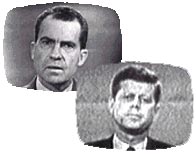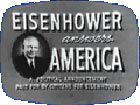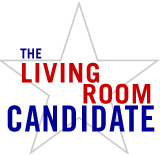| (insert your NIE or newspaper logo here) |
Weekly Online LessonOnline Lesson ArchiveGrade Level: 6-12
|
Presidential Advertising
 Just days after presidential hopeful Senator John Kerry clinched the lead as the Democratic nominee, the first television ads jump-started President George W. Bush's re-election campaign.
Just days after presidential hopeful Senator John Kerry clinched the lead as the Democratic nominee, the first television ads jump-started President George W. Bush's re-election campaign.
On Thursday, March 4, 2004, the Bush campaign began airing two advertisements, featuring images of the World Trade Center after the 9/11 attacks.
Already, experts predict this may become the most expensive advertising campaign in presidential history. Last week alone, the campaign spent about $5 million to broadcast them nationwide on dozens of network and cable stations in 18 states.
So has the marketing blitz been effective? American viewers seem to be having mixed emotions over the TV spots. Some feel using these images for political leverage is disgraceful, while others believe it honors those lost and reminds Americans of this shared experience. The Bush re-election campaign and the White House defend their tactic, stating that it's important to highlight their candidate's ability to respond to terrorists.
Such presidential advertisements have been part of political campaigns since 1952. Many people believe they can be a powerful force in swaying potential voters, with their mix of images, sound, and message. Sometimes these ads show a candidate in a positive light, while others are produced to make the opponent look bad.
With eight months of presidential advertising ahead of us, let's spend this lesson exploring the history of presidential campaigning through television. You'll also find out how and why campaign ads are put together.
The :30 Second Candidate
 Let's start out at The :30 Second Candidate site, part of The Democracy Project at PBS. To view movies, you will need the RealVideo or QuickTime player.
Let's start out at The :30 Second Candidate site, part of The Democracy Project at PBS. To view movies, you will need the RealVideo or QuickTime player.
Start with the Historical Timeline for an overview, beginning in 1939 when Franklin Roosevelt was the first president to appear on television.
Click on next to browse the timeline from 1948 to 1950, 1952, and 1956. How did the political use of the television as a communication tool evolve? What social and economic factors influenced its development? How did Americans react?
Now visit 1960, to 1964, 1966, 1968, 1972, 1976, 1980, and 1984. How did the ads reflect a candidate's personality? How did the different tactics play on America's emotions? In what ways did political commercials end up working for and against a candidate?
Finish up the timeline with 1988, 1990, 1992, 1994, 1996, and 1998. How well did attack ads work? What were some other tactics used?
 Now that you've gotten an overview of the history of these ads, let's look into how their made -- From Idea To Ad.
Now that you've gotten an overview of the history of these ads, let's look into how their made -- From Idea To Ad.
Read the introduction then click next to first meet with the Consultant, Rosser Reaves, to produce the spot, "Eisenhower Answers America."
Take a tour with Reeves, and he'll show you how the Research, Script, and Shooting happen. In what ways was the Eisenhower spot a pivotal event in television and political history? How did Reeves use polls to determine the theme of the ad? What was important about how the images were shot and edited? Why did they choose a blitz approach?
To do all that, though, producers need some Financing. Then there's the Ad Buy strategy to figure out. And so what are the Results? If you'd like, Watch The Spots and browse the Rosser Reeves Collection.
Now that you've got a general idea of how a political commercial gets developed, let's take a closer look at some Tricks of the Trade.
Choose the ad either For The Candidate or Against The Candidate. Move through the movies, seeing how Video, Music, Graphics and Voice Over add to the finished spot. Then review the opposing ad. How did each element of the final commercial make you feel about the candidate?
Turn On The Politics
 Your last stop this week is visiting with The Living Room Candidate at the American Museum of the Moving Image. Here, using a RealOne or Windows Media player, click on the home logo to enter and Set A Video Format.
Your last stop this week is visiting with The Living Room Candidate at the American Museum of the Moving Image. Here, using a RealOne or Windows Media player, click on the home logo to enter and Set A Video Format.
Read the Introduction and use the Election Year Menu, begin browsing in 1952, where you'll see the "Eisenhower Answers America" spots as well as those of his opponent, Adlai Stevenson.
As you review the advertisements, keep thinking about how the images, music, graphics, and voices contribute to the overall tone of each spot.
Continue into 1956 to see how their commercials changed the second time around. For example, how did Stevenson's campaign use Eisenhower's own ads against him? Why did the Eisenhower campaign target women voters and what was the tactic used to do so?
Next, browse through the 1960s. What were some of the social, economic, and security issues highlighted by these ads? How was one candidate's tactic different from his opponent's?
Move on to the 1970s, to see how the rest of the Nixon era played out. How did the music choices shape the tone of these commercials? How well did the ads reflect Jimmy Carter's down-home style, and why would that be attractive to voters?
In the 1980s, you'll learn how the oil shortage and American hostage crisis in Iran heavily influenced the presidential marketing strategies. In what ways did each candidate's campaign use his opponent's background or apparent failures against him?
Finish up with the 1990s. How were the commercials over the years shaped by traditional party lines of Republican and Democrat? What strategies did Independent candidates use?
Newspaper Activities
Watch for articles in Targetnewspaper about people's reactions to this year's presidential advertisements. Exactly what tactics are the campaigns using? Are they more related to a candidate's character and experience, or to current social and economic conditions? Also watch for print ads in your newspaper. How are the wording, design, and message presented? In what ways do these compare to the television ads?
© Copyright 2004
Learners
Online,
Inc.
